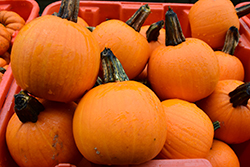Fri & Sat 8am - 8pm
Sun 8am - 7pm
Anytown, USA 12345
fax: 261.787.0463
e-mail: info@successgc.com


Plant Finder

Baby Bear Pumpkin
Cucurbita pepo var. pepo 'Baby Bear'
Height: 18 inches
Spacing: 4 feet
Sunlight:
![]()
Hardiness Zone: (annual)
Brand: Johnny's Selected Seeds
Description:
A lovely, disease resistant, vining plant that produces wonderful pumpkins that kids love; small 6" round, smooth skinned with slight ridges reaching 2lbs each; sweet with fine grained flesh, perfect for pumpkin pies and roasted seeds
Edible Qualities
Baby Bear Pumpkin is an annual vegetable plant that is typically grown for its edible qualities. The entire above-ground parts of the plant are edible, and are typically harvested when mature. The edible parts have a sweet taste and a fleshy texture.
The plant is most often used in the following ways:
- Cooking
- Baking
- Freezing
Planting & Growing
Baby Bear Pumpkin will grow to be about 18 inches tall at maturity, with a spread of 4 feet. When planted in rows, individual plants should be spaced approximately 4 feet apart. This vegetable plant is an annual, which means that it will grow for one season in your garden and then die after producing a crop.
This plant is typically grown in a designated vegetable garden. It should only be grown in full sunlight. It does best in average to evenly moist conditions, but will not tolerate standing water. It is not particular as to soil type or pH. It is somewhat tolerant of urban pollution. Consider applying a thick mulch around the root zone over the growing season to conserve soil moisture. This is a selected variety of a species not originally from North America.; however, as a cultivated variety, be aware that it may be subject to certain restrictions or prohibitions on propagation.
